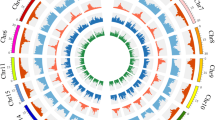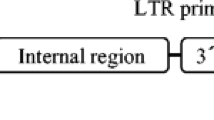Abstract
Activation of retrotransposon is the pivotal factor for the genesis of genetic polymorphism. Retrotransposon-based molecular markers are excellent tools for detecting genetic diversity and genomic changes associated with retrotransposon activity. The scarcity of retrotransposon long terminal repeat (LTR) sequence limits the application of retrotransposon-based molecular marker systems. In this study, retrotransposon 3′-LTR segments were firstly isolated and characterized from the masson pine genome using a genome walking strategy, subsequently inter-retrotransposon amplified polymorphism (IRAP) markers were explored for genetic diversity assessment. These were shown to have clearly distinguishable amplification bands and high levels of polymorphism for masson pine. Dendrogram of our IRAP data highlighted that IRAP markers for individual elements are distinguishable and will shed light on the usage in genetic diversity studies of the masson pine. Transcription activation of Ty1-copia and Ty3-gypsy group retrotransposons in masson pine was investigated with exposure to various abiotic stresses. The insertional polymorphism and the transposition activation were detected by IRAP. Results revealed that none of the analyzed materials in the course of 2-month trials displayed fingerprint changes.





Similar content being viewed by others
References
Abdollahi Mandoulakani B, Piri Y, Darvishzadeh R, Bernoosi I, Jafari M (2011) Diversity in Medicago sativa populations revealed by IRAP and REMAP markers. Plant Mol Biol Report. doi:10.1007/s11105-011-0338-x
Abdollahi Mandoulakani B, Piri Y, Darvishzadeh R, Bernoosi I, Jafari M (2012) Retroelement insertional polymorphism and genetic diversity in Medicago sativa populations revealed by IRAP and REMAP markers. Plant Mol Biol Report 30(2):286–296
Aranzana MJ, Barreneche T, Arús P (2012) Diversity analysis. In: Kole C, Abbott AG (eds) Genetics, genomics and breeding of stone fruits, 55. CRC Press, Boca Raton, USA
Belyayev A, Kalendar R, Brodsky L, Nevo E, Schulman AH, Raskina O (2010) Transposable elements in a marginal plant population: temporal fluctuations provide new insights into genome evolution of wild diploid wheat. Mob DNA 1:6
Biswas MK, Xu Q, Deng XX (2010) Utility of RAPD, ISSR, IRAP and REMAP markers for the genetic analysis of Citrus spp. Sci Hortic 124(2):254–261
Boeke JD, Corces VG (1989) Transcription and reverse transcription of retrotransposons. Annu Rev Microbiol 43:403–434
Cai JJ, Ji KS (2009) Diversity of SSR markers and strategy of genetic linkage map making with masson's pine megagametophytes. Mol Plant Breed 7(5):934–940 (in Chinese with English abstract)
Campbell BC, LeMare S, Piperidis G, Godwin ID (2011) IRAP, a retrotransposon-based marker system for the detection of somaclonal variation in barley. Mol Breed 27:193–206
Carrier G, Cunff LL, Dereeper A, Legrand D, Sabot F, Bouchez O, Audeguin L, Boursiquot JM, This P (2012) Transposable elements are a major cause of somatic polymorphism in Vitis vinifera L. PLoS One 7(3):e32973
Devos KM, Brown JKM, Bennetzen JL (2002) Genome size reduction through illegitimate recombination counteracts genome expansion in Arabidopsis. Genome Res 12:1075–1079
Ding SY, Song YC (1998) Declining causes of Pinus massoniana in the processes of succession of evergreen broad leaved forest. Acta Bot Sin 40:755–760 (in Chinese with English abstract)
Du XY, Zhang QL, Luo ZR (2009) Development of retrotransposon primers and their utilization for germplasm identification in Diospyros spp. (Ebenaceae). Tree Genet Genomes 5:235–245
Fan FH, Wen XP, Ding GJ, Cui BW (2013) Isolation, identification, and characterization of genomic LTR retrotransposon sequences from masson pine (Pinus massoniana). Tree Genet Genomes. doi:10.1007/s11295-013-0631-y
Fedoroff NV (2013) Plant transposons and genome dynamics in evolution. Wiley-Blackwell, Oxford, UK. doi: 10.1002/9781118500156.fmatter
Grandbastien MA (1998) Activation of plant retrotransposons under stress conditions. Trends Plant Sci 3(5):181–187
Grotkopp E, Rejmánek M, Sanderson MJ, Rost TL (2004) Evolution of genome size in pines (Pinus) and its life-history correlates: supertree analyses. Evolution 58(8):1705–1729
Hirochika H, Otsuki H, Yoshikawa M, Otsuki Y, Sugimoto K, Takeda S (1996) Autonomous transposition of the tobacco retrotransposon Tto1 in rice. Plant Cell 8:725–734
Huang CRL, Burns KH, Boeke JD (2012) Active transposition in genomes. Genetics 46(1):651
International Brachypodium Initiative (2010) Genome sequencing and analysis of the model grass Brachypodium distachyon. Nature 463:763–768
Jiang B, Wu ZM, Lou QF, Wang D, Zhang WP, Chen JF (2010) Genetic diversity of Ty1-copia retrotransposons in a wild species of Cucumis (C. hystrix). Sci Hortic 127:46–53
Jin YK, Bennetzen JL (1989) Structure and coding properties of Bs1, a maize retrovirus-like transposon (transposable element/retrotransposon/reverse transcription/translation frameshift). Proc Natl Acad Sci 86:6235–6239
Jing R, Ambrose MA, Knox MR, Smykal P, Hybl M, Ramos A, Ellis TH (2012) Genetic diversity in European Pisum germplasm collections. Theor Appl Genet 125:367–380
Kalendar R, Schulman AH (2006) IRAP and REMAP for retrotransposon-based genotyping and fingerprinting. Nat Protoc 1:2478–2484
Kalendar R, Flavell AJ, Ellis THN, Sjakste T, Moisy C, Schulman AH (2011) Analysis of plant diversity with retrotransposon-based molecular markers. Heredity 106:520–530
Kimura Y, Tosa Y, Shimada S, Sogo R, Kusaba M, Sunaga T, Betsuyaku S, Eto Y, Nakayashiki H, Mayama S (2001) OARE-1, a Ty1-copia retrotransposon in oat activated by abiotic and biotic stresses. Plant Cell Physiol 42(12):1345–1354
Kumar A, Bennetzen JL (1999) Plant retrotransposons. Annu Rev Genet 30:479–532
Li D, Peng SL (2001) Genetic diversity in three Pinus massoniana populations in different elevations and its relationship with ecological factors. Acta Ecol Sin 21:415–421 (in Chinese with English abstract)
Li ZH, Chen Y, Zhang DL, Yang MH, Jiang Y, Ding GJ, Tan XF (2009) ISSR analysis of genetic diversity of Pinnus massoniana on Gupeng and Langshui nature populations in Guangxi. Chin Agric Sci Bull 16:116–119 (in Chinese with English abstract)
Liu FL, Yao JT, Wang XL, Repnikova A, Galanin DA, Duan DL (2012) Genetic diversity and structure within and between wild and cultivated Saccharina japonica (Laminariales, Phaeophyta) revealed by SSR markers. Aquaculture 358–359:139–145
Lou Q, Chen J (2007) Ty1-copia retrotransposon-based SSAP marker development and its potential in the genetic study of cucurbits. Genome 50:802–810
Mandel JR, Dechaine JM, Marek LF, Burke JM (2011) Genetic diversity and population structure in cultivated sunflower and a comparison to its wild progenitou, Helianthus annuus L. Theor Appl Genet 123(5):693–704
Morse AM, Peterson DG, Islam-Faridi MN, Smith KE, Magbanua Z, Garcia SA, Kubisiak TL, Amerson HV, Carlson JE, Nelson CD, Davis JM (2009) Evolution of genome size and complexity in Pinus. PLoS One 4(2):e4332
Nystedt B, Street NR, Wetterbom A, Zuccolo A, Lin YC, Scofield DG, Vezzi F, Delhomme N, Giacomello S, Alexeyenko A, Vicedomini R, Sahlin K, Sherwood E, Elfstrand M, Gramzow L, Holmberg K, Hällman J, Keech O, Klasson L, Koriabine M, Kucukoglu M, Käller M, Luthman J, Lysholm F, Niittylä T, Olson A, Rilakovic N, Ritland C, Rosselló JA, Sena J, Svensson T, Talavera-López C, Theiβen G, Tuominen H, Vanneste K, Wu ZQ, Zhang B, Zerbe P, Arvestad L, Bhalerao R, Bohlmann J, Bousquet J, Gil RG, Hvidsten TR, de Jong P, MacKay J, Morgante M, Ritland K, Sundberg B, Thompson SL, de Peer YV, Andersson B, Nilsson O, Ingvarsson PK, Lundeberg J, Jansson S (2013) The Norway spruce genome sequence and conifer genome evolution. Nature. doi: 10.1038/nature12211
Park M, Jo S, Kwon JK, Park J, Ahn JH, Kim S, Lee YH, Yang TJ, Hur CG, Kang BC, Kim BD, Choi D (2011) Comparative analysis of pepper and tomato reveals euchromatin expansion of pepper genome caused by differential accumulation of Ty3/Gypsy-like elements. BMC Genomics 12:85
Pearce SR, Stuart-Rogers C, Kumar A, Flavell AJ (1999) Rapid isolation of plant Ty1-copia group retrotransposons LTR sequences for molecular marker studies. Plant J 19:1–7
Peng SL, Li QF, Li D, Wang ZF, Wang DP (2003) Genetic diversity of Pinus massoniana revealed by RAPD markers. Silvae Genet 52(2):60–63
Schulman AH, Flavell AJ, Paux E, Ellis TH (2012) The application of LTR retrotransposons as molecular markers in plants. In Mobile Genetic Elements 859:115–153. Humana Press, USA
Smýkal P, Bačová-Kerteszová N, Kalendar R, Corander J, Schulman AH, Pavelek M (2011) Genetic diversity of cultivated flax (Linum usitatissimum L.) germplasm assessed by retrotransposon-based markers. Theor Appl Genet 122:1385–1397
Staton SE, Ungerer MC, Moore RC (2009) The genomic organization of Ty3/gypsy-like retrotransposons in Helianthus (Asteraceae) homoploid hybrid species. Am J Bot 96(9):1646–1655
Stuart-Rogers C, Flavell AJ (2001) The evolution of Ty1-copia group retrotransposons in Gymnosperms. Mol Biol Evol 18(2):155–163
Suoniemi A, Tanskanen J, Schulman AH (1998) Gypsy-like retrotransposons are widespread in the plant kingdom. Plant J 13(5):699–705
Tanksley SD, McCouch SR (1997) Seed banks and molecular maps: unlocking genetic potential from the wild. Science 277(5329):1063–1066
Ungerer MC, Kawakami T (2013) Transcriptional dynamics of LTR retrotransposons in early generation and ancient sunflower hybrids. Genome Biol Evol 5(2):329–337
Vukich M, Schulman AH, Giordani T, Natali L, Kalendar R, Cavallini A (2009) Genetic variability in sunflower (Helianthus annuus L.) and in the Helianthus genus as assessed by retrotransposon-based molecular markers. Theor Appl Genet 119:1027–1038
Wicher T, Keller B (2007) Genome-wide comparative analysis of copia retrotransposons in Triticeae, rice, and Arabidopsis reveals conserved ancient evolutionary lineages and distinct dynamics of individual copia families. Genome Res 17:1072–1081
Yuan LX, Zhang QL, Guo DY, Luo ZR (2012) Genetic differences among ‘Luotian-tianshi’ (Diospyros kaki Thunb.) genotypes native to China revealed by ISSR and IRAP markers. Sci Hortic 137(1):75–80
Zedek F, Šmerda J, Šmarda P, Bureš P (2010) Correlated evolution of LTR retrotransposons and genome size in the genus Eleocharis. BMC Plant Biol 10:265
Zhao GL, Dai HY, Chang LL, Ma Y, Sun HY, He P, Zhang ZZ (2010) Isolation of two novel complete Ty1-copia retrotransposons from apple and demonstration of use of derived S-SAP markers for distinguishing bud sports of Malus domestic acv. Fuji. Tree Genet Genomes 6:149–159
Acknowledgments
The project is supported by grants from Special Core Program of Guizhou Province, P. R. China (20126011–1), the 863 Program of China (2011AA10020301), and the National Natural Science Foundation of China (31260183). We gratefully acknowledge Lianfeng Wu, Harvard Medical School, for critical reading of the manuscript.
Data archiving statement
In this study, there are two obtained sequences have been submitted to the National Center for Biotechnology Information (http://www.ncbi.nlm.nih.gov/), as listed below:
PmRT (GenBank accession no. KC355438)
REPm (GenBank accession no. KC355439)
Author information
Authors and Affiliations
Corresponding author
Additional information
Communicated by D. Neale
Rights and permissions
About this article
Cite this article
Fan, F., Cui, B., Zhang, T. et al. LTR-retrotransposon activation, IRAP marker development and its potential in genetic diversity assessment of masson pine (Pinus massoniana). Tree Genetics & Genomes 10, 213–222 (2014). https://doi.org/10.1007/s11295-013-0677-x
Received:
Revised:
Accepted:
Published:
Issue Date:
DOI: https://doi.org/10.1007/s11295-013-0677-x




